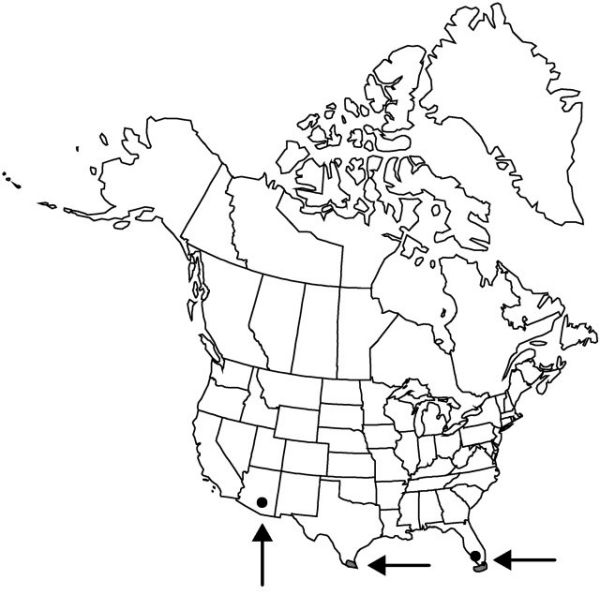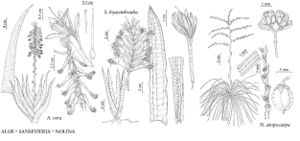Difference between revisions of "Aloe vera"
Fl. Indica, 83. 1768.
imported>Volume Importer |
imported>Volume Importer |
||
| Line 66: | Line 66: | ||
|publication year=1768 | |publication year=1768 | ||
|special status=Introduced;Illustrated | |special status=Introduced;Illustrated | ||
| − | |source xml=https:// | + | |source xml=https://bitbucket.org/aafc-mbb/fna-data-curation/src/2e0870ddd59836b60bcf96646a41e87ea5a5943a/coarse_grained_fna_xml/V26/V26_846.xml |
|genus=Aloe | |genus=Aloe | ||
|species=Aloe vera | |species=Aloe vera | ||
Latest revision as of 21:17, 5 November 2020
Plants short-stemmed, woody-based, stoloniferous. Stems to 50 cm; scarious leaf sheaths persistent. Leaves alternate, rosulate to distichous, 10–50 × 10–70 cm; blade glaucous-green to variegated with small white or glaucous dots, irregular bands, or blotches, often reddish near apex or margins, lanceolate to ensate, tapering from base to apex, glabrous, margins green, spiny-toothed, teeth 1–1.5 cm apart. Inflorescences terminal, usually unbranched, racemose, 10–15 dm, usually covered with scalelike bracts; racemes cylindrical, dense, 0.5 m; bracts glabrous or puberulent, with 3 prominent purple veins that are confluent at tips. Flowers: perianth yellow; tepals prominently 3-veined, connate basally for 1/2 their length, lobes broadly linear to oblong-lanceolate, apex rounded; stamens 6, included to slightly exserted, slightly unequal; filaments 2–2.5 cm; anthers 2.5–4 mm; style usually exserted; stigmas not expanded; pedicel 2.2–3.3 cm. Capsules somewhat elongate. 2n = 14.
Phenology: Flowering spring–winter, occasionally at other times.
Habitat: Hammocks, sandy areas, roadsides, and similar places in full sun
Elevation: 0 and 1300 m
Distribution

Introduced; Ariz., Fla., Tex., Mediterranean region and Atlantic islands (Canary, Madeira, and Cape Verde).
Discussion
This is the aloe of commerce and source of bitter aloe. Most of the world’s supply is grown in southern Texas and adjacent northwestern Mexico and the West Indies. The species is thought to be native to the Atlantic islands and is widely used as an indoor ornamental. It is often cultivated outdoors in the southwestern United States, where it occasionally escapes.
Selected References
None.
